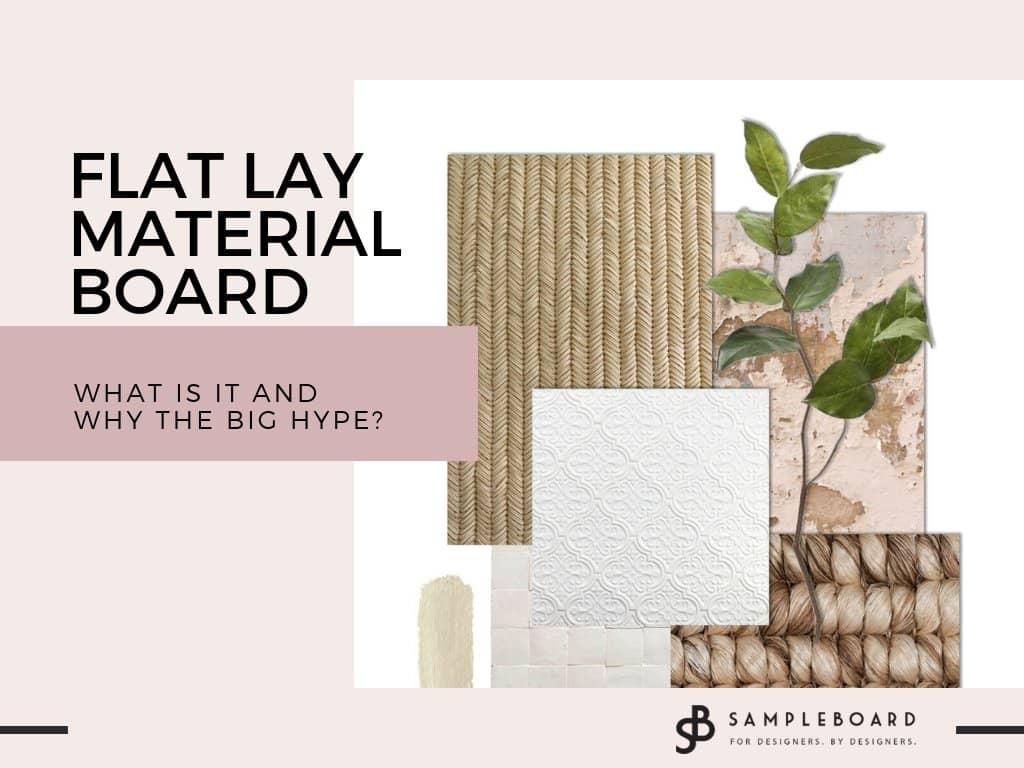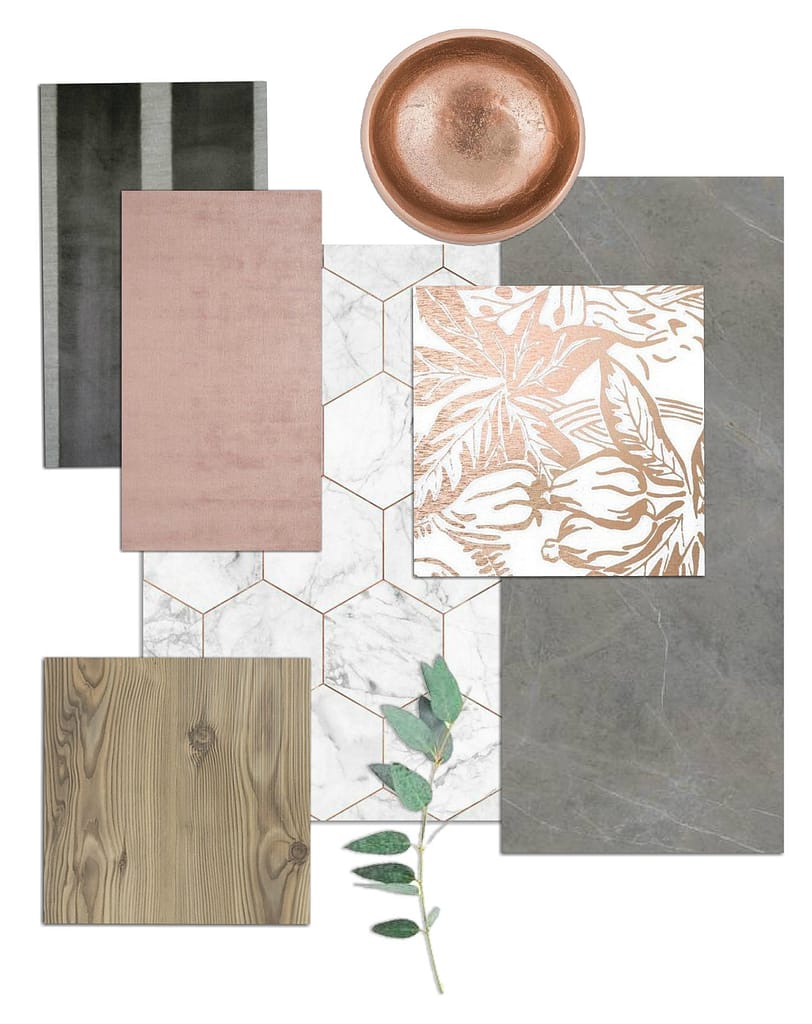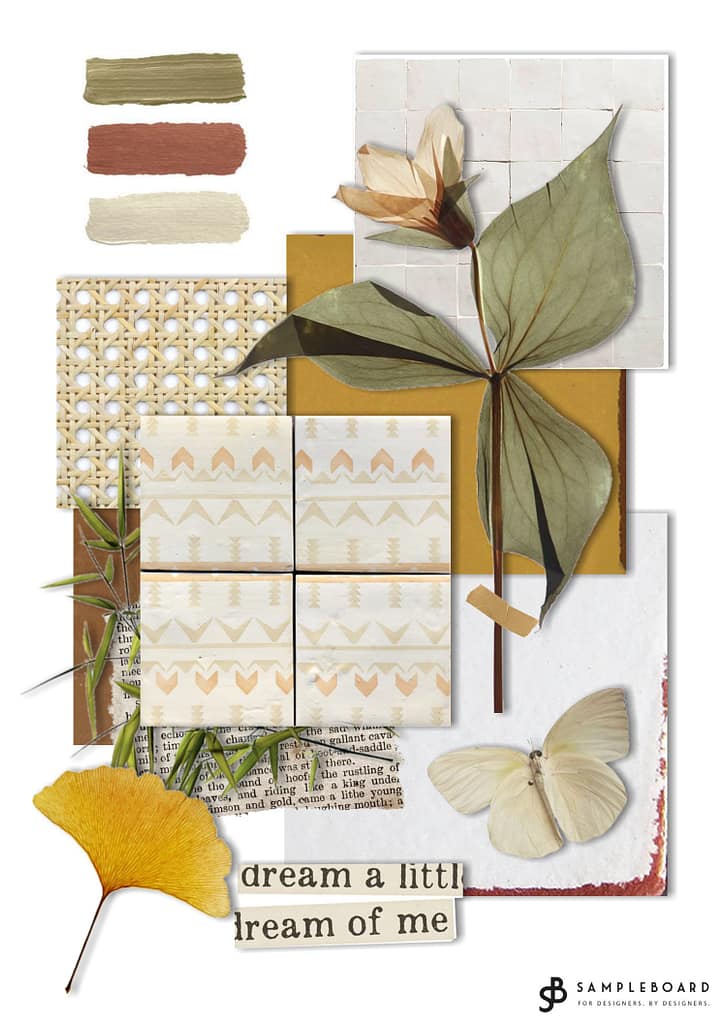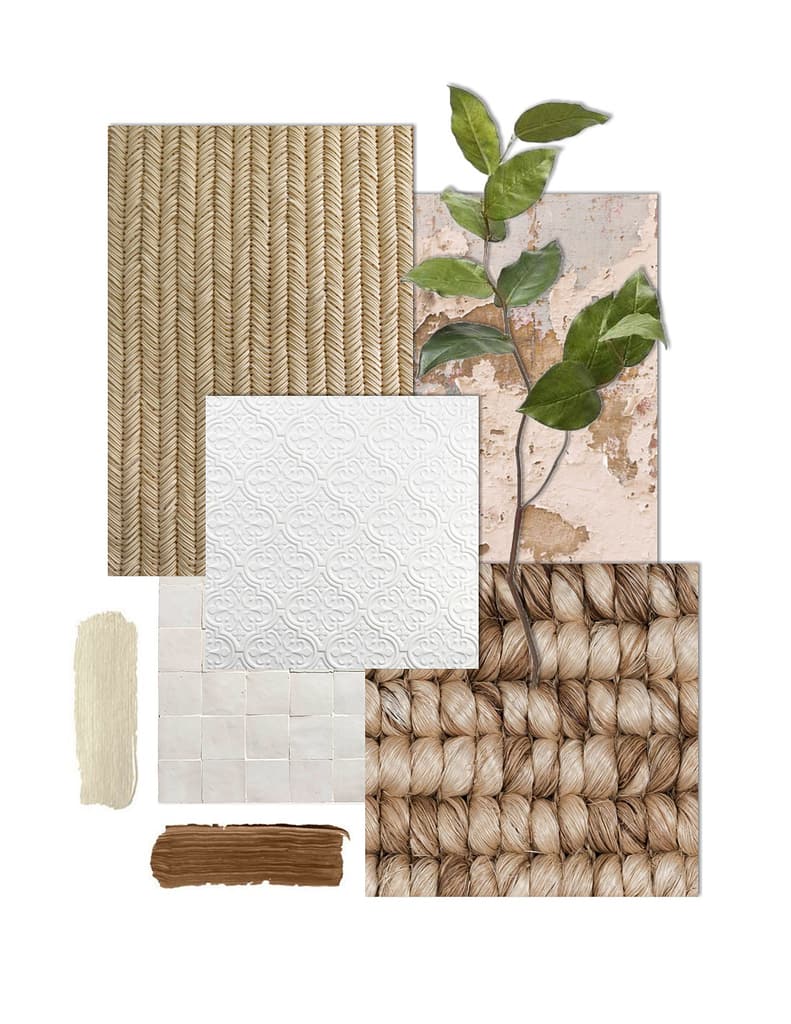Last Updated on October 24, 2024 by SampleBoard

A flat lay material board is a visual presentation tool used by interior designers, decorators, stylists, and influencers to convey color stories, material palettes, textures, and design concepts.
Unlike traditional mood boards that compile images, a flat lay board physically arranges the actual materials into a cohesive composition. The materials are carefully styled and photographed as a still life.
Flat lays allow designers to showcase the exact fabrics, finishes, paint swatches, flooring samples, and other physical elements specified for a design scheme.
This provides an authentic and tangible representation of the look and feel.

The materials are thoughtfully arranged, sometimes with deliberate white space, to highlight color relationships, patterns, and textures. This brings the concept to life in a vivid, 3-dimensional way.
Flat lays are an impactful tool for interior designers to communicate and sell their vision to clients. They also help build excitement and understanding around the design.

Flat lay material boards offer several key benefits for interior designers:
Material boards allow designers to bring their vision to life in a tangible way. Seeing actual samples of fabrics, finishes, textures, and colors helps designers better conceptualize how elements will look together in the final design.
This allows them to experiment and refine designs before implementation.
Material boards are a helpful visual aid when presenting design concepts and options to clients. Seeing real material swatches helps clients better understand and choose between proposed options. This propels the design process forward.
Curating material samples into a cohesive board allows designers to conceptualize and test color combinations, patterns, and motifs.
Designers can ensure elements complement each other and flow visually. This aids in creating holistic designs that clients will love.
By collaging physical material samples into a flat lay composition, interior designers unlock key benefits throughout the design process.
The boards become both a design tool and a presentation piece that brings visions to life.

A well-styled flat lay material board creates visual harmony by carefully choosing complementary materials that work together.
When selecting different fabrics, wood tones, metals, wallpapers, tiles, and other elements, focus on balancing textures and applying color theory.
Smooth silks paired with rough wood surfaces make for interesting contrasts. But be sure to maintain cohesion through color.
Analogous colors like blue, green, and yellow are soothing. Complementary colors like orange and blue pop when combined. Monochromatic palettes with varying shades and tones of a single hue also work beautifully.
Additionally, ensure there is a good flow between materials. Repeat colors, textures, shapes, or other features throughout the board. This creates repetition and consistency.
Use color weighting to establish dominance. The eye will naturally follow a path through the board, so make strategic choices when positioning materials.
With a thoughtful curation of each element and awareness of design principles, a flat lay board comes together looking polished, professional, and pulled together.

A flat lay material board showcases the actual physical materials an interior designer plans to use in a space. This allows clients to see and feel the textures, colors, and patterns first-hand.
When sourcing materials, focus on collecting:
Aim for 15-25 material samples in total. Overlap materials to create a pleasing composition. Materials should coordinate and tell a story about the design concept.
Keep an eye on color balance, texture, and visual flow.

Material boards require some basic tools and supplies to create. The most important is the board itself, which provides the base for mounting materials.
Interior designers often opt for foam core boards for flat lays, as they are lightweight yet sturdy. An 18" x 24" foam core board is a good standard size to start with.
Adhesives are needed to affix material samples onto the board. Double-sided tape is commonly used since it's removable and won't damage delicate materials.
Spray adhesive is another option for securing heavier samples like tile or wood.
Cutting tools come in handy for trimming materials to size. A metal ruler and craft knife allow for straight cuts and clean edges. Rotary cutters, scissors, and guillotine paper cutters are also useful.
Pins, clips, and stencils can help arrange materials and create borders or patterns. Using a level and pencil ensures elements are positioned evenly.
Having these basic tools on hand gives interior designers flexibility when sourcing and composing one-of-a-kind material boards.
The supplies are easy to find at local craft stores or online. With some boards, adhesives, and cutting implements, designers can produce beautiful, professional flat lays.

The key to getting great photos of your material board is lighting, angles, and determining if you want a digital or print version.
It's important to have soft, even lighting when photographing your board. Natural light from a window is ideal, but you can also use a flash or constant light source. Avoid harsh shadows or uneven lighting. Position your board perpendicular to the light source.
Shoot your board straight on, but also photograph details and angles. Get creative with your angles - shoot from above, the side, or on an angle. This allows you to highlight specific materials and textures.
Decide if you need a digital version to email or share online or a high-quality print. For digital, use a camera or phone camera in landscape orientation.
For print, use a DSLR on a tripod for maximum image quality. Shoot in RAW format for the most flexibility in post-processing.
Use photo editing software to adjust color, crop, and make the materials pop. For prints, choose a high-quality paper like matte or metallic.
For digital, create a gallery of the best images or a video flip-through of the details. Present to clients in a customized PDF, printed book, or on a branded website.

Creating a material board requires both purchasing materials as well as the time to source, arrange, style, and photograph the materials.
This results in real costs that interior designers must consider when offering these boards to clients.The material costs can vary widely based on the specific materials chosen.
Simple material boards may only require inexpensive fabrics, paint swatches, tiles, and wood samples which can be purchased fairly cheaply.
However, sourcing unique or high-end materials like wallcoverings, textiles, hardware, and lighting can get pricey quickly. Rarely will a designer use all inexpensive samples, so expect at least $50-100+ in materials per board.
The labor time involved is also a significant cost factor. If researching and sourcing interesting materials, this can take many hours of work. Styling, photographing, and editing great shots is also very time-consuming.
While DIY designers may account for their own time at a lower rate, professional interior designers who outsource this work or value their time highly will want to account for 10+ hours potentially at $50-150 per hour.
When pricing these material boards for clients, most interior designers add up the material costs, labor time, overhead, and any outsourcing fees.
Then they markup the total cost anywhere from 2-4x to account for profit margin. This results in prices from $200 on the low end, up to $1000+ for more complex luxury material boards.
Clients pay a premium for the designer's time, expertise, and unique materials that go into curating and producing an inspiring board just for their project.
Flat lay material boards have become an increasingly popular tool for interior designers for a few key reasons:
With the rise of platforms like Instagram and Pinterest, visual marketing has become crucial for service-based businesses like interior design.
A carefully styled flat lay board photograph can showcase an interior designer's aesthetic and skills while generating brand awareness.
Using relevant hashtags and geotags helps the images get discovered by ideal potential clients.
During the client onboarding and design process, a physical flat lay board allows designers to lay out proposed materials, colors, textures, and styles in one collage.
This brings concepts and recommendations to life in a tactile, engaging way. Being able to touch, feel, and see specific elements side by side helps clients visualize the designer's vision.
Sharing images of their flat lay boards on social media or portfolios allows designers to highlight their skills in pulling together cohesive palettes and styles.
This attracts potential clients by showcasing the designer's capabilities in an authentic and aesthetic way. The visually pleasing marketing material reflects the meticulous eye and taste they bring to their work.
Traditionally, interior designers have used mood boards to plan and communicate the look and feel of a space.
Mood boards are collages of images, fabric swatches, paint chips, and other small samples arranged on a board. They provide a conceptual visualization of the style.
Flat lay material boards have some key differences from classic mood boards:
So in summary, flat lay material boards provide a more realistic, physical representation of the materials that will make up the finished design.
They allow the client to see and feel the actual elements that will be used. This creates a stronger visual impression than conceptual mood boards.
Flat lay material boards are quickly evolving along with technology and design tools. Here are some ways they may change and improve in the near future:
Virtual Designs
With augmented and virtual reality becoming more advanced and affordable, interior designers can create digital flat lay material boards.
These virtual boards allow clients to visually explore materials and colors in 3D spaces through a mobile device or VR headset.
Designers can upload rooms, swap out materials, and make revisions in real time during client meetings.



AI-Generated
Interior design apps are leveraging AI to automatically generate flat lay material boards based on a designer's input.
Developers are training algorithms on millions of interior design photos to understand aesthetics, color theory, material compatibility, and more.
This allows apps to instantly produce professional, cohesive material boards that designers can customize.

Interactive Material Boards
Beyond static photos, material boards may become interactive for clients. Using multimedia features, clients could click on a material sample to see a short video demonstrating textures.
Or they could drag-and-drop materials onto a 3D rendering of the room space to preview options. With embedded tags and info, clients could easily purchase curated products directly through the board.
Flat lay is the term used when a sample or item is viewed from the top. It has become increasingly popular on Pinterest and Instagram, and often called 'material boards'.
Here's an example of a digital flat lay material board created using SampleBoard.



As always, the more you practice and source the web for continuous inspiration, the better your creative eye and in turn your flat lay and mood boards will become.
Happy creating!